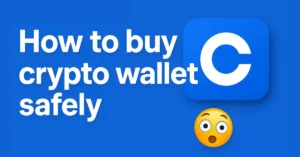The Role of Nodes in Blockchain
Introduction
Blockchain is a powerful technology changing how we store and share data. From cryptocurrencies like Bitcoin to secure digital contracts, blockchain is being used in more and more areas. But if you’re just starting to learn about it, some of the terms can feel confusing, especially the word “nodes.”
So, what exactly are nodes, and why do they matter?
In simple terms, nodes are the computers that help keep a blockchain system running. They work together to store data, verify transactions, and keep everything secure. Without nodes, there would be no blockchain.
In this blog post, we’ll break down the role of nodes in an easy-to-understand way. You’ll learn what they are, the different types of nodes, how they work, and why they’re so important to blockchain technology.
Let’s get started!
What are Nodes in Blockchain?

In the world of blockchain, a node is simply a computer that connects to the blockchain network. These computers communicate with each other and help keep the entire system working smoothly.
Each node plays a vital role in storing, sharing, and verifying information on the blockchain. Think of it like this: if blockchain is a shared online notebook, nodes are the people who have a full or partial copy of that notebook and help make sure every page is correct and updated.
Here’s a simple example:
Imagine a group of friends playing a game where they all write down the scores. Every time someone scores a point, they all update their notebooks. If one person makes a mistake, the others can help correct it by comparing notes. This is how nodes work — they help check and confirm information so that everyone agrees on what’s true.
In short, nodes are the building blocks of a blockchain network. Without them, there would be no one to store data, verify transactions, or keep the system secure.
Types of Nodes
Not all nodes are the same. Different nodes have different responsibilities in a blockchain network. Let’s go over the main types of nodes and what they do:
Full Nodes
- Full nodes are the most important type. They store a complete copy of the blockchain, including every transaction and block from the beginning.
Their main jobs are to:
- Check and verify new transactions and blocks.
- Make sure everything follows the rules of the network.
- Share updates with other nodes.
Because they store a lot of data, full nodes need more storage space and internet power. But they also offer the highest level of trust and security.
Light Nodes (or Lightweight Clients)
Light nodes don’t store the full blockchain. Instead, they only keep the most important parts — like the block headers — and rely on full nodes for the rest.
Their main benefits:
- They use less storage and power.
- They’re great for mobile devices or basic wallets.
However, since they don’t verify everything themselves, they trust full nodes to provide correct information.
Mining Nodes / Validator Nodes
These nodes are responsible for creating new blocks in the blockchain. Depending on the type of blockchain, they may be called:
- Mining nodes in blockchains like Bitcoin (which use Proof of Work).
- Validator nodes in blockchains like Ethereum 2.0 (which use Proof of Stake).
Their role is to:
- Compete or get selected to add new blocks.
- Confirm that transactions are valid before including them.
- Earn rewards for their work (like coins or fees).
Masternodes (optional and used in some blockchains)
Masternodes are special full nodes that perform extra tasks such as:
- Enabling faster or private transactions.
- Voting on network decisions.
- Managing budgeting systems in some blockchain projects.
They usually require a large investment to run and are used in networks like Dash.
Each type of node plays a different role, but together, they make the blockchain network secure, reliable, and decentralized.
Core Functions of Nodes
Nodes are more than just computers on the network — they are the backbone of the entire blockchain system. Each node performs several important tasks to keep everything running safely and smoothly. Here are the core functions of nodes:
Verifying Transactions
One of the main jobs of a node is to check whether a transaction is valid before it is added to the blockchain. For example, a node will:
- Make sure the sender has enough balance.
- Confirm that the transaction follows the network’s rules.
- Reject any suspicious or invalid transactions.
This verification process helps keep the blockchain honest and free from fraud.
Storing Blockchain Data
Nodes store a record of all transactions and blocks on the network. Full nodes keep a copy of the entire blockchain history. This stored data helps:
- Prove that a transaction happened.
- Keep the network transparent and trustworthy.
- The more full nodes there are, the more secure and reliable the network becomes.
Sharing and Propagating Information
Once a new transaction or block is verified, nodes share this information with other nodes in the network. This is called propagation.
It works like a ripple effect:
- One node sends data to others, and they pass it along until all nodes are updated. This helps everyone stay in sync with the latest information.
Helping Reach Consensus
Blockchain networks need to agree on which transactions and blocks are valid. This agreement is called consensus.
Nodes help reach consensus by:
- Voting on the validity of new blocks.
- Following a common set of rules or algorithms (like Proof of Work or Proof of Stake).
- Rejecting blocks that don’t meet the network’s standards.
This process keeps all copies of the blockchain consistent across the network.
Supporting Decentralization
Nodes are spread across the world, and no single person or group controls them all. This decentralized structure:
- Makes the blockchain more secure.
- Reduces the risk of hacking or failure.
- Builds trust among users.
Each node adds strength to the network just by being part of it.
Together, these functions make nodes the most important part of any blockchain system. They help build a network that is secure, transparent, and decentralized.
How Nodes Communicate
For a blockchain to work properly, all the nodes in the network need to stay in touch and share information. This communication happens through a system called a peer-to-peer (P2P) network.
In a peer-to-peer network, each node connects directly with other nodes, like a web of computers sharing data without needing a central server. Let’s break down how this communication works:
Peer-to-Peer Connections
- Each node is connected to several other nodes. When one node gets new information — like a transaction or a new block, it immediately shares it with its peers.
- Then, those peers share it with their peers, and so on, until the entire network receives the update.
This process is fast and efficient, ensuring that everyone stays up to date.
Broadcasting Transactions and Blocks
When someone makes a new transaction:
- It’s sent to a nearby node.
- That node broadcasts it to others in the network.
- The nodes check the transaction and, if it’s valid, include it in a block.
The same happens when a new block is created:
- It’s broadcast to all other nodes.
- They verify it, and if it’s valid, they add it to their copy of the blockchain.
Synchronization Between Nodes
Nodes must be in sync so that they all agree on the current state of the blockchain. To do this:
- Nodes constantly compare their data with other nodes.
- If a node falls behind or joins the network late, it downloads the missing blocks to catch up.
This way, all nodes have the same version of the blockchain.
Communication Protocols
Nodes use special rules called communication protocols to talk to each other. These protocols make sure that:
- Data is shared in a standard format.
- Messages are sent and received correctly.
- The network runs smoothly even with thousands of nodes.
Each blockchain (like Bitcoin or Ethereum) has its protocol, but the idea is the same: to allow safe and fast communication between nodes.
In summary, nodes use peer-to-peer connections, broadcasting, synchronization, and protocols to stay connected, share data, and agree on the truth. This communication is what allows the blockchain to function without any central control.
Why Nodes Are Important
Nodes are not just part of the blockchain — they are the foundation that keeps the entire system running. Without nodes, the blockchain wouldn’t exist. Here’s why nodes are so important:
They Keep the Network Secure
- Nodes play a major role in protecting the blockchain from fraud and attacks. They carefully check each transaction to make sure it follows the rules. If someone tries to add a fake transaction or block, the honest nodes will reject it.
- The more nodes a blockchain has, the harder it is for hackers to take control — because they would need to fool a majority of the network, which is almost impossible in a large, well-distributed system.
They Make the Blockchain Decentralized
- One of the biggest advantages of blockchain is decentralization — there’s no single authority in control. This is only possible because of nodes.
- Each node stores and shares the same data. This means no one person or company owns the blockchain, and everyone can verify the truth for themselves.
They Store the Blockchain’s History
Nodes store copies of all past transactions and blocks. This is important because it:
- Keeps a permanent, unchangeable record.
- Helps users check where funds came from.
- Makes the system transparent and trustworthy.
Even if some nodes go offline, others still have the full history, so the network keeps running smoothly.
They Help the Blockchain Stay Online
Since nodes are spread across the world, the blockchain doesn’t rely on a single point of failure. If one node crashes or disconnects, the rest of the network keeps going. This makes the system extremely reliable and available 24/7.
They Support Fairness and Trust
Because every node follows the same rules and has access to the same data, all users are treated equally. No one can cheat, hide, or change the rules for their own benefit. This builds a system based on fairness and trust.
In short, nodes are what make blockchain secure, transparent, decentralized, and trustworthy. Without them, the entire idea of blockchain would fall apart.
Running a Node: Can Anyone Do It?
Yes — in most cases, anyone can run a node on a blockchain network. You don’t need to be a developer or a tech expert. However, it’s important to understand what it involves and what you’ll need to get started.
What Do You Need to Run a Node?
To run a full node, you’ll need:
- A computer with enough storage space (often hundreds of gigabytes, depending on the blockchain).
- A strong internet connection that stays online most of the time.
- Some technical knowledge is required to install and manage the node software.
Time and patience, especially during the setup phase, as downloading the full blockchain can take hours or even days.
Why Would Someone Want to Run a Node?
Running a node can have many benefits:
- Support the network: By running a node, you help keep the blockchain secure and decentralized.
- Independence: You don’t have to rely on others — you can verify transactions yourself.
- Privacy: Instead of using third-party services, you can interact directly with the blockchain.
- Incentives: In some blockchains, node operators may earn rewards (this usually applies to mining or validator nodes).
Examples of Popular Blockchains Where You Can Run a Node
- Bitcoin: Anyone can run a full Bitcoin node to verify transactions and blocks.
- Ethereum: You can run a full node or become a validator if you’re participating in Ethereum 2.0 staking.
Other blockchains like Litecoin, Cardano, and Solana also allow users to run nodes, with different setup requirements.
Is It the Same as Mining or Staking?
Not exactly. While mining nodes and validator nodes also run full node software, their goal is to add new blocks to the blockchain and earn rewards. Running a regular full node doesn’t earn rewards by default — it’s more about contributing to the network’s strength and transparency.
In short, yes, you can run a node, and doing so is a great way to become more involved in the world of blockchain. It takes some effort, but it’s one of the best ways to understand how these systems work.
Step-by-Step Guide: The Role of Nodes in Blockchain and How It Works

Understanding how nodes work in a blockchain might seem complex at first, but when broken down step by step, it becomes much easier to follow. Here’s how nodes play their role in the blockchain system from start to finish:
Step 1: A Transaction Is Created
- A user initiates a transaction. For example, Alice wants to send Bitcoin to Bob.
- This transaction is created and signed using Alice’s private key.
- The transaction is sent to the blockchain network, where nodes will pick it up.
Step 2: Transaction Broadcasted to Nodes
- Once created, the transaction is broadcast to nearby nodes (usually full nodes).
- Each node receives the transaction and shares it with other connected nodes in the peer-to-peer network.
Step 3: Nodes Verify the Transaction
The nodes verify the transaction details, such as:
- Is the digital signature valid?
- Does Alice have enough balance?
- Is the transaction following all blockchain rules?
If the transaction is valid, it is added to a pool of pending transactions (called the mempool).
Step 4: A Block is Created by a Mining/Validator Node
- A mining node (Proof of Work) or a validator node (Proof of Stake) selects valid transactions from the pool and starts forming a block.
- In Proof of Work (like Bitcoin), miners compete to solve a puzzle. In Proof of Stake (like Ethereum 2.0), validators are selected to propose a block.
Step 5: The New Block is Broadcast to All Nodes
Once the block is created, the node broadcasts the new block to the rest of the network.
All nodes receive the block and verify its contents, making sure:
- The transactions inside are valid.
- The block follows the rules.
- The cryptographic proof (like the hash) is correct.
Step 6: Nodes Reach Consensus
The network uses a consensus algorithm (like Proof of Work or Proof of Stake) to agree on whether to accept the new block.
- If the majority of nodes agree, the block is added to the blockchain.
- This updated version of the blockchain is now considered the official record.
Step 7: The Blockchain is Updated Across All Nodes
- Once the block is accepted, every full node adds the new block to its copy of the blockchain.
- This keeps all nodes in sync and ensures that everyone sees the same history.
Step 8: The Process Repeats
- New transactions continue to be created.
- Nodes keep verifying, sharing, and updating the blockchain.
This cycle keeps the network secure, transparent, and running without any central authority.
Key Takeaway
Every step in this process shows how important nodes are. From verifying transactions to reaching consensus and storing the blockchain’s history, nodes are the heart of the blockchain system. They work together to keep everything accurate, secure, and decentralized.
Frequently Asked Questions (FAQs)
What is a node in simple words?
A node is a computer that connects to a blockchain network. It helps store, verify, and share data to keep the blockchain running smoothly and securely.
Do all nodes do the same thing?
No, not all nodes are the same. Some nodes store the full blockchain (full nodes), some only store part of it (light nodes), and others create new blocks (mining or validator nodes).
Is a node the same as a miner?
Not exactly. A miner or validator is a special type of node that creates new blocks and earns rewards. But not all nodes mine or validate — many just help store and verify data.
Can I run a node from home?
Yes! Anyone with a computer, an internet connection, and some technical knowledge can run a node. You’ll need storage space and patience to set it up, but it’s doable.
Does running a node make me money?
Running a regular node usually doesn’t earn you money. Only mining nodes or validator nodes can earn rewards, depending on the blockchain.
Why are nodes important in blockchain?
Nodes are the backbone of the blockchain. They:
Keep the network secure
Verify every transaction
Store the full history
Support decentralization
Without nodes, blockchain wouldn’t work.
Are nodes safe from hacking?
Yes, nodes are generally secure, especially because they are decentralized. If one node is hacked or goes offline, the rest of the network keeps working.
How do nodes stay updated?
Nodes share data with each other in real-time through a peer-to-peer network. They constantly sync with other nodes to make sure they have the latest version of the blockchain.
What happens if a node goes offline?
If a node goes offline, the blockchain doesn’t stop. Other nodes keep the network running. When the offline node comes back, it can catch up with the latest data.
Which blockchains allow users to run nodes?
Most major blockchains like Bitcoin, Ethereum, Litecoin, and Cardano allow anyone to run a node — each with different system requirements.
Conclusion
Nodes are the heart of blockchain technology. They work together to verify transactions, store data, and keep the network secure and decentralized. Without nodes, blockchain wouldn’t be possible. Whether you’re using blockchain for payments, contracts, or anything else, understanding nodes helps you see how this technology stays trustworthy and reliable. Running a node may take effort, but it’s a great way to support and be part of the blockchain world.
Bonus Points
- Nodes Help Prevent Fraud: Since every node verifies transactions independently, it’s almost impossible to cheat the system or double-spend coins.
- More Nodes = More Security: The strength of a blockchain network grows as more nodes join, making it more resistant to attacks and failures.
- Running a Node Increases Privacy: When you run your node, you don’t have to trust third parties with your transaction data, keeping your activity more private.
- Nodes Support Blockchain Upgrades: When blockchains update or improve, nodes decide whether to accept these changes, helping maintain the network’s health.
- Different Blockchains Have Different Node Rules: Some blockchains require special hardware or staking to run nodes, while others are more accessible.
- Nodes Can Help Detect Problems: By comparing data, nodes can spot errors or malicious activity and help fix issues quickly.
- Community-Driven Network: Nodes are often run by individuals and organizations worldwide, creating a truly global and decentralized system.
Also read
- What is a Crypto Wallet and How Does It Work? – Coinsify
- 10 Crypto Terms Every Beginner Must Know – Coinsify
- What is Blockchain Technology – Complete Guide – Coinsify
- How to Buy Crypto Safely in 2025 – Complete Guide – Coinsify
- Bitcoin vs Ethereum: Key Differences Explained – Complete Guide
- Ultimate Blockchain Glossary: Learn Blockchain Terms Easily
- How to Buy Bitcoin Safely (Complete Beginner’s Guide)
- Top 10 Crypto Wallets for Beginners (2025 Edition)
- What is Cryptocurrency? A Beginner-Friendly Guide (2025)






